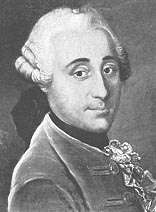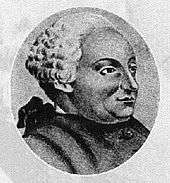Jean François de Saint-Lambert
Jean François de Saint-Lambert (26 December 1716 – 9 February 1803) was a French poet, philosopher and military officer.
Jean François de Saint-Lambert | |
|---|---|
 | |
| Born | 26 December 1716 |
| Died | 9 February 1803 (aged 86) |
| Title | Marquis de Saint-Lambert |
| Partner(s) | Émilie du Châtelet Sophie d'Houdetot |
| Children | Stanislas-Adélaïde du Châtelet, born on 4 September 1749, died on 6 May 1751 (aged 1) |
Biography
Saint-Lambert was born at Nancy and raised on his parents' estate at Affracourt, a village in Lorraine near Haroué, a seat of the Beauvau family, with whom he had close ties. He studied at the university at Pont-à-Mousson, but then spent several years at home recovering from an unidentified illness.[1] He often complained of poor health, but participated in military campaigns,[2] led a strenuous social life, and lived to be 86 years old.
Saint-Lambert began writing poetry in his adolescence and belonged to the circle around Françoise de Graffigny in Lunéville. By October 1733 he had already begun work on The Seasons, his major poetical work, which did not appear in print until 1769 (see 1769 in poetry).[3] All his life, he read his works in salons and to his friends, but did not rush to publish them.
In 1739, Saint-Lambert joined the Heudicourt regiment in the Lorraine Guards, in which his boyhood friend, Charles-Just, prince de Beauvau-Craon, was already a colonel, despite being only 19 years old. For much of the 1740s the two men fought side by side in the Italian campaigns of the War of the Austrian Succession.
Saint-Lambert spent the winter quarter in Lunéville in 1745-46, and according to François-Antoine Devaux, he became at that time the lover of the Marquise de Boufflers.[4] She was a sister of the prince de Beauvau, and the mistress of Stanislaus Leszczynski, who had been established in 1737 as duke of Lorraine.
Over the winter of 1747-48, Voltaire and his entourage took up residence in Lunéville. Saint-Lambert soon began a liaison with the great writer's mistress, Émilie du Châtelet.[5] She was in her forties, and had had many lovers, but succumbed to a mad passion for Saint-Lambert and became pregnant with his child. The baby, a girl named Stanislas-Adélaïde Du Châtelet, was born on 4 September 1749 in what at first seemed an easy delivery; but Émilie contracted a fever and died on 10 September. The infant died in Lunéville on 6 May 1751.[6]
Émilie was a brilliant and learned woman, known all over Europe for her translation of Newton. Her love affair and pregnancy created scandal and inspired satirical mirth; her death was a shock to everyone. Voltaire was shattered, and according to his friend Devaux, so was Saint-Lambert, who nonetheless moved to Paris around 1750 and to all appearances soon recovered from his grief.[7]
It was at this time that he gave himself the title Marquis de Saint-Lambert, to which he had no right; it was once claimed that he was not even of noble birth, but the evidence refuting that charge was published long ago.[8]
In 1752 he began the second of his two famous love affairs, with Sophie d'Houdetot. This relationship became noteworthy because in 1757, while Saint-Lambert was away on military duty in the Seven Years' War, Jean-Jacques Rousseau suddenly conceived a mad passion for Sophie, which he wrote about in his Confessions. In Rousseau's mind, she became identified with a character in the great novel he was then writing, Julie, ou la Nouvelle Héloïse. In the end, Sophie turned Rousseau away, saying that she loved Saint-Lambert.[9] She and Saint-Lambert remained together as a couple until his death in 1803, spending their last years in a cordial ménage à trois with her husband.[10]
Saint-Lambert resigned from the army in 1758 and devoted the rest of his life to literature. He wrote several articles for Diderot's Encyclopédie, published an essay on "Luxury" in 1764, brought out an edition of The Seasons with a selection of his other poetry and some short stories in 1769, and completed a multi-volume philosophical work in 1797-98, called Principe des mœurs chez toutes les nations ou Catéchisme universel (Principle of morals among all nations, or universal catechism).[11] He wrote the section on "Siam", and most likely also other parts of the first edition of Guillaume Thomas François Raynals L'Histoire philosophique et politique des établissements et du commerce des Européens dans les deux Indes.[12] He was elected to the Académie française in 1770.
He and Sophie outlived most of their contemporaries, however, and around 1800 members of a new generation wrote about them as relics of a legendary past. Count Louis-Mathieu Molé described the fabled lover as "a little old man dressed in a hideous cotton dressing gown with a pattern of blue stripes and red bouquets, a wispy cotton bonnet on his head, using a cane walking stick with a gold knob as tall as he was to support his wobbly steps."[13] Chateaubriand used the couple as symbols of a discredited era, when he wrote that they "both represented the opinions and the freedoms of a by-gone age, carefully stuffed and preserved: it was the eighteenth century expired and married in its manner. It was sufficient to remain steadfast in one's life for illegitimacies to become legitimacies."[14]
References
- Roger Poirier, Jean-François de Saint-Lambert, 1716-1803, Sarreguemines: Éditions Pierron, 2001, pp. 22-24.
- Poirier, pp. 75-87.
- J. A. Dainard, ed. Correspondance de Madame de Graffigny, Oxford: Voltaire Foundation, 1985-- (in progress), vol. 1, p. 7.
- J. A. Dainard, ed., Correspondance de Madame de Graffigny, vol. 8, pp. 156-57.
- The story of this affair figures prominently in all complete biographies of Voltaire. See for example René Vaillot, Avec Mme Du Châtelet, Oxford: Voltaire Foundation, 1988, pp. 355-99. For a study focussed on Saint-Lambert, and incorporating new information, see D. W. Smith, "Nouveaux regards sur la brève rencontre entre Mme Du Châtelet et Saint-Lambert." In The Enterprise of Enlightenment. A Tribute to David Williams from his friends. Ed. Terry Pratt and David McCallam. Oxford, Berne, etc.: Peter Lang, 2004, p. 329-343. See also Anne Soprani, ed., Mme Du Châtelet, Lettres d'amour au marquis de Saint-Lambert, Paris, 1997.
- See D. W. Smith, "Nouveaux regards".
- See D. W. Smith, "Nouveaux regards", and J. A. Dainard, ed., Correspondance de Madame de Graffigny, vol. 9.
- Georges Mangeot. Autour d'un foyer lorrain: la famille de Saint-Lambert (1596-1795). Paris: Croville-Morant et Nancy: Sidot, 1913.
- The story of this affair figures prominently in all complete biographies of Rousseau. The edition of Rousseau's Confessions by Bernard Gagnebin and Marcel Raymond, in the "Bibliothèque de la Pléiade" Œuvres complètes de Jean-Jacques Rousseau, vol. 1, Paris: Gallimard, 1964, provides a discussion and extensive notes about the incident, and the edition of Julie, ou la nouvelle Héloïse in the same series, vol. 2, ed. Henri Coulet and Bernard Guyon, Paris: Gallimard, 1964, provides similar background on Sophie's role in the composition of the novel.
- Poirier, Jean-François de Saint-Lambert, pp. 301-306.
- Kafker, Frank A.: Notices sur les auteurs des 17 volumes de « discours » de l'Encyclopédie (suite et fin). Recherches sur Diderot et sur l'Encyclopédie Année (1990) Volume 8 Numéro 8 p. 115
- Jonathan I. Israel, Democratic Enlightenment, Oxford University Press, 2012, p. 421.
- "un petit vieillard habillé d’une vilaine robe de chambre de cotonnade rayée bleu sur bleu, parsemée de bouquets rouges, un bonnet de coton à mèche sur la tête et soutenant ses pas chancelants par une canne de jonc à pomme d’or aussi haute que lui." Count Molé, Souvenirs de jeunesse, 1793-1803, quoted by Jacques-Alain de Sédouy, Le comte Molé ou la séduction du pouvoir, Paris, 1994, pp. 44-45.
- François-René de Chateaubriand, Mémoires d'outre-tombe, ed. Edmond Biré, Paris: Garnier, 1899-1900, vol. 2; Part 2, Book 2; often reprinted.
